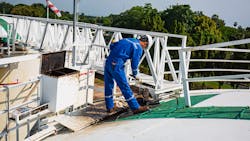Technology innovation takes tank gauging to new heights
Level measurement technology has evolved significantly over the last 50 years and has expanded to serve many applications over the years. The journey from such rudimentary methods as knocking on tank walls to mechanical floats and electronic servo-based methods to today, where non-contacting radar systems are at the forefront, has been swift. It’s also been guided by the changing needs and automation requirements of industry. What started as a way to measure level in storage tanks on oil-tankers at sea has evolved to include more marine vessel types and applications, over to onshore petroleum storage tanks, chemical tanks, other energy storage, level measurement in food & beverage industries, and many more applications.
“There are lots of storage tanks out in the world. Historically the technology was applied in the oil and gas industry, but these days, driven by automation trends and an increasing valuation of products and raw materials, tank gauging solutions are needed in a much wider range of applications,” says Mikael Helmer, general manager for tank gauging at Emerson.
Helmer says tank gauging technology and associated systems has evolved, itself, over the last two decades. “The preference for non-contacting, continuous level measurements continue to grow,” he says. “But, in addition, tank gauging is about volumetric measurements in the end, and level with radar is a key piece to that. But associated measurements, such as temperature, pressure, volume calculations are other key measurements to deliver what a customer expects from a complete tank gauging system.”
Customer needs have driven the technology innovation here as well. More accurate temperature measurements, tank and liquid pressure measurements, more volume calculations and diagnostics are a few such valuable inputs to your stored product. “Changes in how you monitor your data, what you want to do with it, the way customers expect to have easy access to data via mobile systems is driving the technology forward and demands scalability, flexibility and open communication protocols to and from the system,” Helmer says.
“Safe operations of tank farms has become an extremely important piece over the recent years—you don’t want to spill your product,” he continues. “Tank overfills are a major concern, and since many products stored are flammable, hazardous and explosive, it is critical to take actions to protect health, lives, environment and plant assets, to ensure and improve safe workplaces and surrounding communities. So, using the reliable, accurate radar technology for overfill prevention is addressing those concerns.”
The ability to continuously monitor bulk liquid levels as they move around from tank, to train, to ship, to tank again is paramount. “Storage is about the movement of product, so you need to have good control of your inventory and the transfers between the different locations,” Helmer says of the common usage for his company’s tank gauging technologies. “It’s not only that you’ve managed to put a batch of product inside your tank. You need to know how much you got, transferred or received, all while doing it in a safe manner.”
Soon after its introduction many years back, measuring level with radar quickly became a more precise and reliable measurement versus the older mechanical methods. Helmer says even the more modern servo solutions still present a lot of inherent challenges that come with moving mechanical parts and is often related with high maintenance costs. Radar, on the other hand, has no moving parts, no contact with the product, and essentially no maintenance. With stable, accurate and maintenance-free radar technology, the reliability and longevity offered to the customer are excellent and have fueled its rise in technology preference.
Always ready for your next challenge
Over the years, Emerson’s radar tank gauging technology has been further developed, listening to customer needs and looking at customer pains to be solved. Currently the fourth generation land-based system continues to provide customers with their tank gauging needs, with focus around efficient plant operations, safety and overfill prevention solutions, accuracy of tank inventory and scalability both in terms of size of the plant but also in terms of applications and products stored. “Customers appreciate the reliability and overfill prevention capabilities in our system” Helmer says. "Our 2-in-1 technology provides dual level data in two independent layers of protection using only one housing and a single tank nozzle. This unique feature has been a successful adder during the past decade, helps reduce installation time and cost, not the least in existing tanks with only one opening, such as floating roof tanks with still-pipes and LPG tanks."
Legacy technologies are still in use in many places, but the need for replacing and upgrading tank gauging systems is increasing. "Our flexibility and scalability of the system allows for step-by-step, tank-by-tank upgrades, in the pace of investments the customer prefers. This means the use of the latest tank gauging technology from Emerson can be applied where the need is most prevalent.
“The operator interface, TankMaster, is another strong solution that we continue to develop and invest in. Making sure we provide net volume calculation based on major industry standards, such as API and ISO, is key for inventory management. Here, connectivity to other systems and instant insights into your tank farm whenever you need it, wherever you are and by different functions of a plant is another important need that we solve through our TankMaster Mobile solutions,” Helmer says.
“We are also offering a complete system solutions for cryogenic storage of liquefied gas,” he continues. Full containment tanks are advanced tanks, with lots of measurement points and safety functionality. Being able to help customers with a one-stop-shop solution has proven very attractive to many customers who operate LNG and Ethylene tanks in both Energy and Chemical industries.
As tank gauging systems based on radar technology continues to develop, while keeping its inherent features and capabilities, Helmer says more industries are showing interest in utilizing the technology.
About the Author

Leaders relevant to this article:

